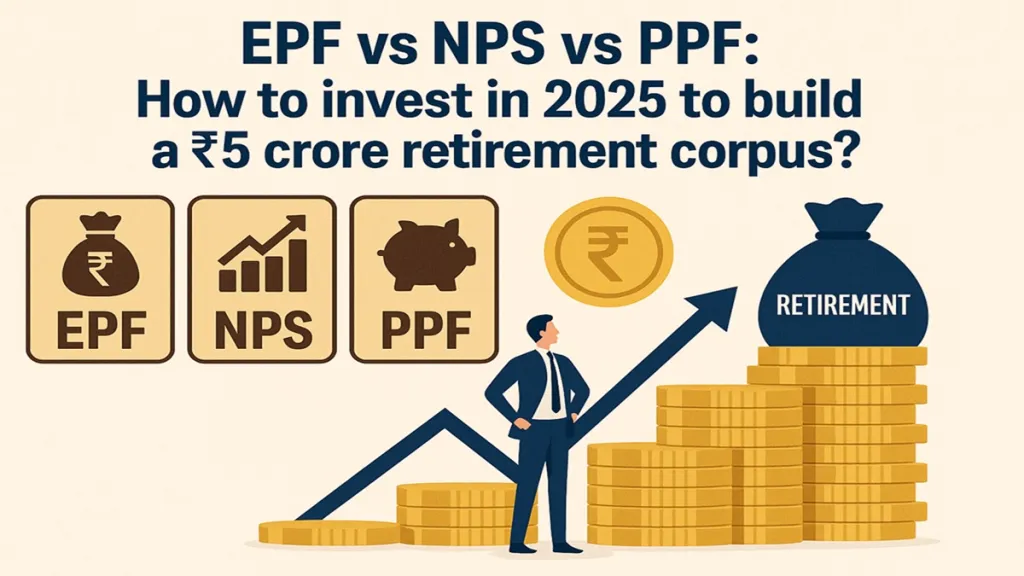Retirement planning has become more important now than ever. Given the rising inflation, increase in life expectancy and limited social security facilities, retirement planning is no longer an option but a necessity.
If you are in your 30s and want to have a strong retirement corpus at the age of 60, it is important to formulate the right investment strategy from now on.
In this story, we focussed on traditional investment cum retirement savings products like EPF, PPF and NPS to see how much one needs to invest in these instruments to retire with a decent corpus of Rs 5 crore. We spoke to experts and tried to know what strategy should be adopted for investing in these schemes in 2025.
Also read: Forget finance gurus, watch Panchayat: The unexpected money guide we all need
NPS: High returns, but also market risk
According to Ranbheer Singh Dhariwal, Group Head – Social Security & Welfare, Protean eGov Technologies Ltd, NPS has a higher equity exposure, so in the last decade, it has given an average annual return of 8% to 12%. On the other hand, the average return of EPF and PPF has been 8–9%.
NPS is also said to be very beneficial in terms of tax benefits, he says, adding “NPS is considered a 3E superpower — Exempt at investment, Exempt on growth, and Exempt at withdrawal — which is not available in any other scheme.” However, this tax system can also change in the future, according to him.
How to reach a Rs 5 crore retirement corpus through EPF, NPS, and PPF
Let’s suppose a 30-year-old individual is earning Rs 1 lakh per month and begins investing in NPS and PPF while also contributing to EPF.
For EPF, a total monthly contribution of Rs 7,835 (including 12% from the employee and 3.67% from the employer) is made on a basic salary of Rs 50,000. With an assumed annual salary increment of 5%, the contribution increases proportionally each year. Over 30 years, this results in an EPF corpus of Rs 2 crore.
Now, assume the individual invests Rs 10,000 per month in an NPS account, which grows to around Rs 1.5 crore over 30 years at an assumed annual return of 8%.
Coming to PPF — a monthly investment of Rs 12,500 (i.e., Rs 1.5 lakh annually, the maximum permitted limit that also qualifies for Section 80C deduction) can accumulate to a corpus of Rs 1.5 crore in 30 years.
Summing up, this individual needs to invest on a monthly basis Rs 7,835 in EPF, Rs 10,000 in NPS and Rs 12,500 in PPF for 30 years to make a corpus of Rs 5 crore on retirement. So if he is investing a little over Rs 30,000 per month in these three schemes, the Rs 5 crore goal can be achieved over 30 years.
Also read: Rs 1 crore in Mutual Funds by 33: One man’s journey that redefines ‘easy money’
EPF and PPF: Stability with low risk
Taxflick.com CFO Gaurav Sharma compares the three schemes in detail.
EPF is a retirement scheme for salaried employees, whose return is currently 8.25% per annum. Investors are eligible for tax exemption of up to Rs 1.5 lakh annually and the entire amount is tax-free on maturity. If someone invests Rs 27,000 every month in EPF from the age of 30, he can create a fund of up to Rs 5 crore by investing about Rs 97 lakh by the age of 60.
PPF is a government-backed long-term savings scheme, which currently gives an annual return of 7.1%. However, its annual investment limit is Rs 1.5 lakh, due to which it is not possible to create a fund of Rs 5 crore in it, he adds.
Gaurav Sharma says, “If an investor wants a safe and tax-free option, then EPF and PPF are better, but the returns will be low. Whereas there is some risk in NPS, but the chances of returns are higher.” Is a mixed investment strategy better?
Both experts believe that it is not wise to depend on a single scheme. Sharma suggests investing Rs 30,000 every month across these three schemes. This will balance the risk while saving tax and can give good, tax-free returns in the long term, he believes.
Also read: The hidden financial wisdom in Krishna – Sudama story
Pay attention to risk and tax, not just returns
If your goal is to build a retirement corpus of Rs 5 crore, NPS can be an attractive option — provided you are not afraid of market fluctuations. EPF and PPF are better suited for those who want guaranteed returns and low risk.
It is important that investors do not make decisions based only on past returns. As Dhadiwal says, “Past returns are not a guarantee of future, before investing, take a decision keeping in mind your financial situation, risk appetite and goals.”
Therefore, while planning your investment in 2025, it would be better to adopt a balanced portfolio.
FinancialExpress.com does not endorse any specific investment instruments. Readers are encouraged to make their own informed decisions, as any losses incurred will be their sole responsibility.

